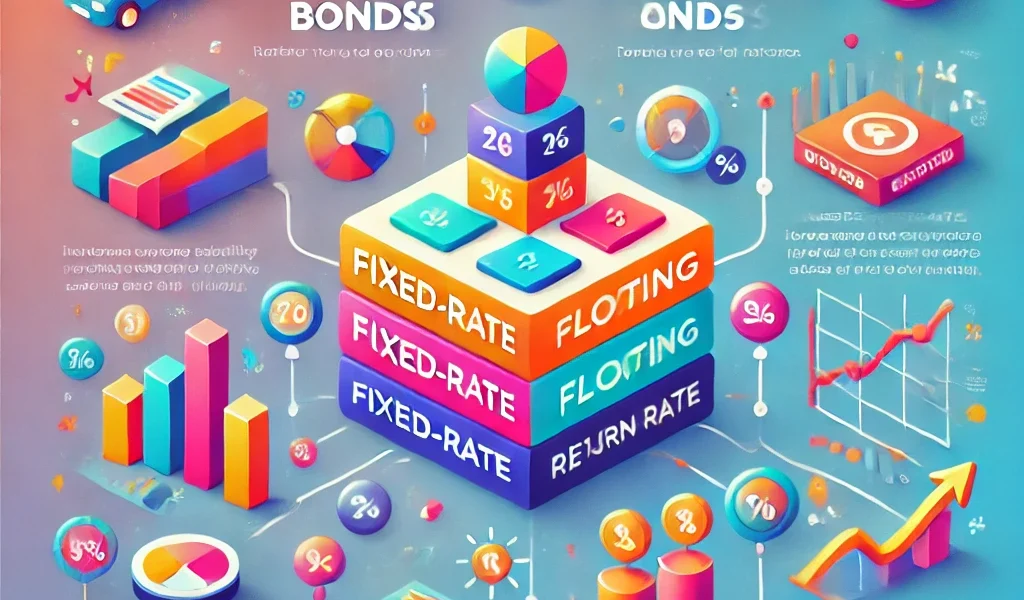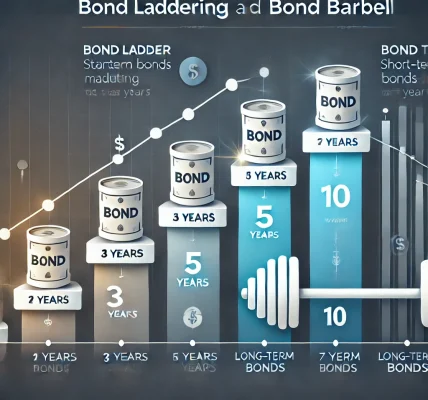Introduction
Investors seeking stable returns often turn to bonds as a reliable option. However, choosing between fixed-rate bonds and floating-rate bonds can be a challenging decision, especially in a dynamic interest rate environment. While both types of bonds provide periodic income, their performance varies based on interest rate fluctuations, making it essential for investors to understand their unique characteristics before investing.
In this blog, we’ll compare fixed-rate and floating-rate bonds, analyze their pros and cons, discuss their suitability for different market conditions, and provide a guide to help investors choose the right option.
🎯 What Are Fixed-Rate Bonds?
Fixed-rate bonds are debt instruments that pay a consistent interest rate (coupon) to investors throughout the bond’s life, regardless of market interest rate fluctuations. These bonds offer predictable income and are ideal for conservative investors seeking stability.
✅ Key Features of Fixed-Rate Bonds:
- Fixed Coupon Rate: Interest payments remain the same until maturity.
- Price Sensitivity: Bond prices fluctuate inversely with changes in interest rates.
- Stable Income: Provides consistent returns over the bond’s tenure.
Example:
- A 10-year fixed-rate bond with a 5% annual coupon will pay ₹5,000 on a ₹1,00,000 investment annually, regardless of market conditions.
📊 How Do Fixed-Rate Bonds Work?
When an investor buys a fixed-rate bond:
- They receive periodic interest payments based on the fixed coupon rate.
- The bond’s price fluctuates in the secondary market based on changes in prevailing interest rates.
- If interest rates rise, the price of the fixed-rate bond falls, and vice versa.
📈 Advantages of Fixed-Rate Bonds
1. 📝 Predictable Returns
Fixed-rate bonds provide a stable and predictable income stream, making them attractive for retirees and risk-averse investors.
2. 🛡️ Low Volatility
Since the interest rate is fixed, bondholders do not face the uncertainty of fluctuating payments.
3. 📚 Capital Preservation
Fixed-rate bonds help preserve capital and ensure principal repayment upon maturity.
⚠️ Disadvantages of Fixed-Rate Bonds
1. 📉 Interest Rate Risk
When market interest rates rise, fixed-rate bond prices fall, resulting in potential capital losses if sold before maturity.
2. ⏳ Inflation Risk
Fixed-rate bonds may underperform during inflationary periods, as the real value of interest payments declines.
🎯 What Are Floating-Rate Bonds?
Floating-rate bonds (FRBs) are bonds with variable interest rates that reset periodically based on a benchmark rate, such as LIBOR (London Interbank Offered Rate), SOFR (Secured Overnight Financing Rate), or government bond yields. These bonds provide higher returns in a rising interest rate environment.
✅ Key Features of Floating-Rate Bonds:
- Variable Coupon Payments: Interest rates adjust at regular intervals (e.g., quarterly or semi-annually).
- Benchmark-Linked Rate: Coupons are tied to a benchmark rate plus a spread.
- Interest Rate Sensitivity: FRBs perform well when interest rates rise.
Example:
- A floating-rate bond with an interest rate of LIBOR + 2% will adjust its coupon payments periodically to reflect changes in the LIBOR rate.
📊 How Do Floating-Rate Bonds Work?
When an investor buys a floating-rate bond:
- Interest payments fluctuate based on changes in the benchmark rate.
- The bond’s price remains relatively stable as the interest rate adjusts to market conditions.
- Investors benefit from rising interest rates but face lower returns when rates decline.
📈 Advantages of Floating-Rate Bonds
1. 📊 Protection Against Rising Interest Rates
FRBs adjust their coupon payments to reflect rising interest rates, providing higher returns during rate hikes.
2. 💡 Price Stability
Unlike fixed-rate bonds, FRBs maintain relatively stable prices, even in a changing interest rate environment.
3. 📚 Inflation Hedge
Floating-rate bonds protect investors from the adverse effects of inflation by aligning coupon payments with market rates.
⚠️ Disadvantages of Floating-Rate Bonds
1. 📉 Lower Returns in a Falling Rate Environment
When interest rates decline, floating-rate bond yields decrease, resulting in lower income for investors.
2. 🛑 Complexity and Uncertainty
Floating-rate bonds can be more complex to understand and may not be suitable for conservative investors seeking predictable income.
🔥 Fixed-Rate vs. Floating-Rate Bonds: Key Differences
| Feature | Fixed-Rate Bonds | Floating-Rate Bonds |
|---|---|---|
| Interest Rate | Fixed for the bond’s tenure | Variable, linked to benchmark |
| Price Sensitivity | High (inverse to rate changes) | Low, due to rate adjustments |
| Returns in Rising Rates | Lower returns | Higher returns |
| Returns in Falling Rates | Higher returns | Lower returns |
| Risk Level | Lower in stable environments | Higher due to rate uncertainty |
| Ideal for | Conservative, income-seeking investors | Aggressive, risk-tolerant investors |
📈 Which Bond is Better During Different Market Conditions?
✅ Fixed-Rate Bonds:
- Best in a stable or declining interest rate environment when bond prices remain stable or appreciate.
- Suitable for long-term investors seeking predictable income and minimal risk.
✅ Floating-Rate Bonds:
- Best in a rising interest rate environment when rates increase and floating-rate bonds generate higher returns.
- Ideal for investors who expect inflation and rising rates in the near future.
🎯 When Should You Choose Fixed-Rate Bonds?
✅ Stability and Predictability: Ideal for retirees and conservative investors who prioritize consistent income.
✅ Falling Interest Rate Environment: If rates are expected to decline, fixed-rate bonds lock in higher yields.
✅ Capital Preservation: Fixed-rate bonds ensure principal repayment at maturity.
📊 When Should You Choose Floating-Rate Bonds?
✅ Rising Interest Rate Environment: Floating-rate bonds benefit when rates increase, offering higher returns.
✅ Inflation Protection: Protects against purchasing power erosion by aligning coupon payments with inflation.
✅ Diversification: Adding floating-rate bonds to a fixed-income portfolio reduces overall interest rate risk.
📝 Tax Implications for Fixed-Rate and Floating-Rate Bonds
✅ Fixed-Rate Bonds: Interest income is taxable at ordinary income rates.
✅ Floating-Rate Bonds: Coupon payments are also taxed as ordinary income, but capital gains or losses may apply if sold before maturity.
✅ Municipal Bonds: Fixed or floating municipal bonds may offer tax-free income at the federal and state levels.
⚖️ Legal Considerations to Avoid Risks
To minimize legal exposure and regulatory issues:
✅ Disclosure of Risks: Clearly communicate the risks of fixed and floating-rate bonds.
✅ Compliance with Regulatory Guidelines: Ensure adherence to regulations issued by SEBI (India) or SEC (USA).
✅ Investor Suitability: Assess whether the bond aligns with the investor’s financial profile and objectives.
📚 Case Study: Choosing the Right Bond for Market Conditions
Scenario:
- Investor A expects interest rates to rise in the next 12 months.
- Investor B anticipates declining rates over the next 5 years.
✅ Investor A’s Choice: Floating-rate bonds to benefit from rising rates.
✅ Investor B’s Choice: Fixed-rate bonds to lock in higher yields before rates decline.
🎉 Conclusion: Which Bond is Right for You?
The choice between fixed-rate and floating-rate bonds depends on an investor’s risk tolerance, market outlook, and financial goals. Fixed-rate bonds offer stability and predictable returns, while floating-rate bonds provide protection against rising interest rates and inflation. A balanced portfolio that includes both types of bonds can help investors mitigate risk and maximize returns in various market conditions.



